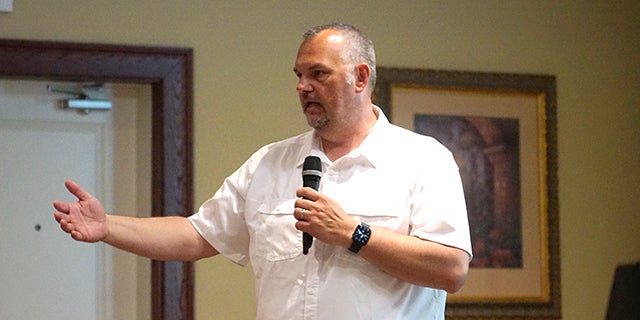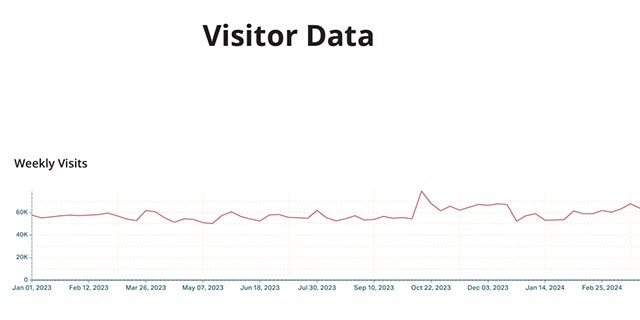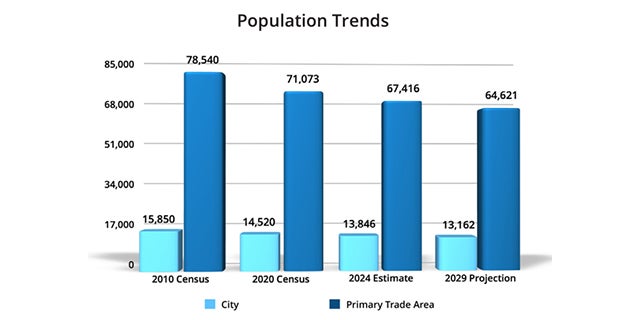What’s Next? Consultant provides breakdown of Retail Market Analysis
Published 3:07 pm Friday, April 26, 2024

- Joe Borgstrom of Place + Main Advisors presents marketing data to Main Street community partners on Wednesday, April 17, at the Natchez Grand Hotel. (Sabrina Robertson | The Natchez Democrat)
|
Getting your Trinity Audio player ready...
|
NATCHEZ — Staggering numbers presented during a two-day program last week organized by the non-profit Downtown Natchez Alliance showed potential for growth and business development for downtown Natchez.
Approximately 50 participated in the “walking and visioning tour” on April 16. The following day, another 70 people heard a possibilities presentation at the Natchez Grand Hotel, where an updated Natchez downtown retail market analysis was presented.
But how were these numbers obtained? More important, how can they be used to benefit Natchez?
DNA recently hired an outside consultant Joe Borgstrom of Place + Main Advisors to produce the retail market analysis report that outlines the number of visits to downtown, the trade area, average household income and retail leakage.
This was done with $1,000 from the DNA organization plus U.S. Department of Agriculture grant funds. Now it’s up to the community to utilize this data to its advantage.
Borgstrom, in his report, said market demands are almost always met, but not necessarily at home. Customers will leave their local trade area to find what they need in other places. The analysis provides an overview of local market demands that are not being met locally.
With that, he identified at least a dozen different business opportunities for the downtown area.
What happens next?
Chesney Doyle, a member of the DNA Board of Directors, described the “Destination Downtown Real Estate Gameplan” and how this market analysis will help reach DNA’s goals.
DNA President Jo Ann Brumfield also presented this game plan to downtown merchants this week during their monthly meeting at the Natchez Coffee Company.
“We will be working with our local real estate community to identify local entrepreneurs (and) business owners specifically who might benefit from this data with second locations or to expand into additional business segments; identify vacant or available real estate buildings or property; and match available property inventory with potential business types,” Doyle said.
Borgstrom also provided professional pro forma financial statements to four downtown building owners which they can utilize to help develop, activate, or sell their properties.
Where do the numbers come from?
Geofencing data traced from cell phone activity within a certain area was used to show that the downtown Natchez Main Street district received 2 million-plus visits between January 2023 and January 2024, Borgstrom said.
To clarify, Borgstrom said these “visits” came from both residents and workers in the downtown area as well as tourists, including anyone who came into the virtual parameter of the Main Street district and stayed for at least seven minutes to potentially rule out drive-through traffic. One individual – such as a resident or business owner – could generate hundreds or thousands of visits over the course of the year, depending on his or her actions in downtown.

This graph in the market analysis presented shows the number of visits to the downtown area based on geofencing data.
The market analysis looks at each individual visit to the downtown Natchez Main Street district — even if the same person coming and going is counted multiple times — as an opportunity to do business.
“The data only uses the term ‘visitor’ and not ‘customer,’” explained Borgstrom. “Visitors are potentially customers, but not always exclusively.”
Using the same geofencing data, Borgstrom identified the primary trade area where most of these visitors are coming from.
“Retail leakage data,” which is the difference that the average household within this trade area would spend on an annual basis and the market supply, is then obtained.
“We get our retail leakage data from a company called Claritas and its subsidiary, Environics Analytics. Their clients include GM, Kroger, and Omni Hotels & Resorts among dozens of others,” Borgstrom said. “Their data is derived from a proprietary system that uses the Consumer Expenditure Survey from the Bureau of Labor Statistics and the Census of Retail Trade from the U.S. Census Bureau. This database then pulls data from the appropriate geographies based on the trade area that was defined.”
Growth projection

Another graph from the market analysis shows population and projections based on U.S. Census data.
Borgstrum’s report cited Census estimates that projected a nearly 20% decline in population from 2010 to 2024 in Natchez as well as a 6.8% decline in households in the primary trade area. The difference in spending is projected to increase by roughly $1,500 per household over the course of the next five years, Borgstrom said.
“That’s only an average increase of $300 per household per year. So, while it is growing, it is not growing as fast as it would if population and household numbers were increasing,” he said.
With an average household income of $62,127 within the trade area, the 2024 demand is an estimated $1,173,352,338 and supply is $1,168,261,042, which shows an opportunity gap of $5,091,296. Demand is projected to increase to $1,215,122,636 by 2029 and the supply gap to $46,861,594, Borgstrom said.
“While there seems to be a downward trend in population and households, I do think there is significant opportunity for businesses and development in Natchez,” he said.
A further breakdown of this supply gap shows retail opportunities for furniture stores and home furnishings; supermarkets and grocery stores; beer wine and liquor stores; optical goods (eyeglasses) stores; men’s, children and family clothing stores and clothing accessories; pet and pet supply stores; art dealers; full-service restaurants; snack and non-alcoholic beverage bars.
“The economic vitality work that DNA is doing is all about growing our downtown economy to make sure that Natchez continues to be a place that our children, grandchildren, and generations to come will want to call home,” Doyle said. “Last year, in conjunction with Mississippi Main Street, we worked with Dr. Rachael Carter of MSU Extension Services, who conducted a Retail Market Analysis and a Retail Gap Study, which included a Community Survey with nearly 500 respondents.”
Doyle said the 2022 survey combined with the retail analysis provides baseline data and economic projections to help guide downtown growth.
Both reports can be downloaded from DNA’s website, www.natchezdna.org.




